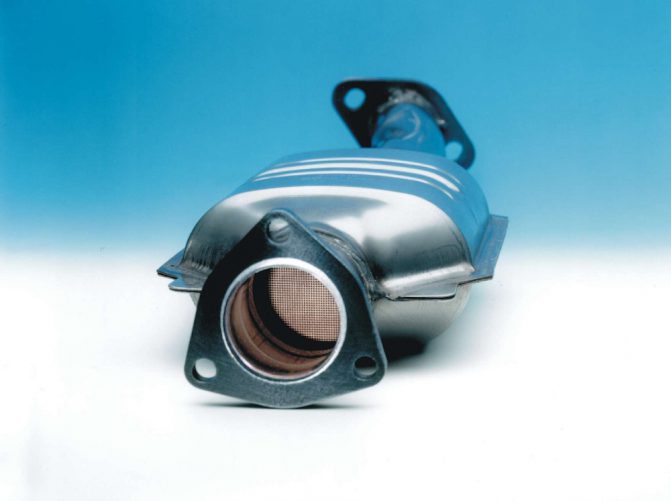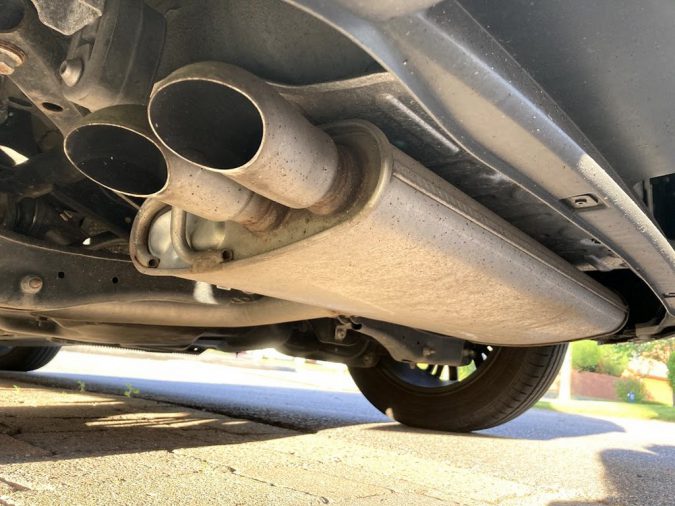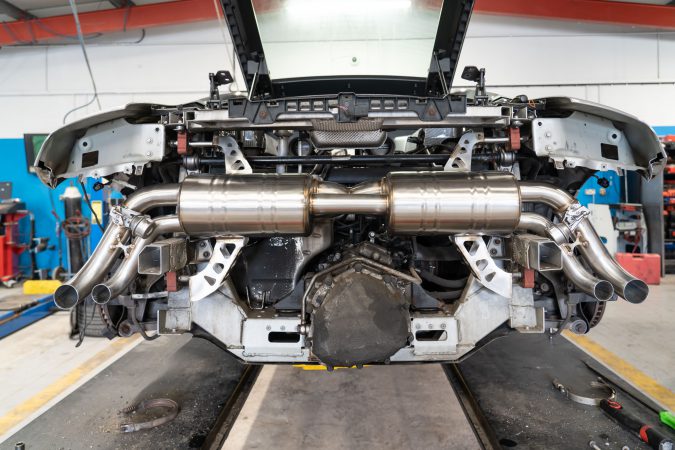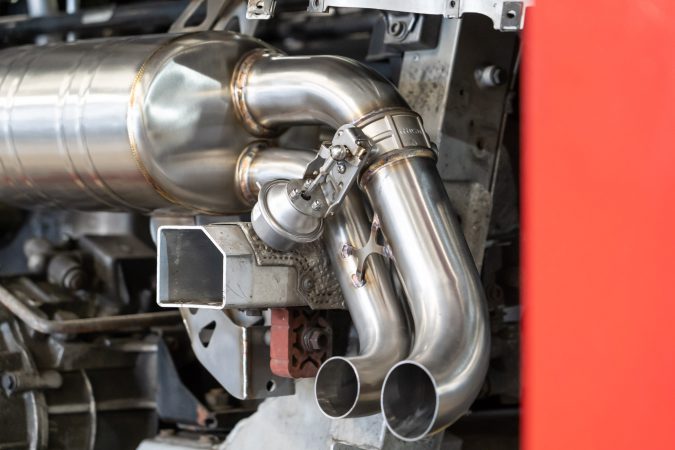The aftermarket and tuning scene is rife with a myriad of tips and tricks which promises to yield you more power. Among the most common – and straightforward – ones involve getting more air into the engine. Be it retrofitting a cold air intake, or adding in bigger headers, there are numerous methods to ramp up the volume of air going into the engine. But how about a high flow catalytic converter?
Besides, all that atmosphere entering the engine has to leave somewhere, right? As your car exhales, it would make sense that freeing up your exhaust fumes would entail the car breathing a bit easier. In that regard, it ought to improve the performance of the engine. But does bolting on and tuning a high flow catalytic converter be worth all the trouble? After all, cats are monstrously expensive.
It’s not a myth that making a car breathe smoother and quicker enhances power. Simply swapping in a freer air intake could net you double-digit horsepower gains right quick. In addition, we also know that streamlining the flow of exhaust gases has a similar effect. These include using straight pipes or deleting the mufflers to open up the gas flow. Would a high flow catalytic converter do the same?
- What Does A “Cat” Do?
- How Does It Work?
- Effects On Performance
- What’s A High-Flow Cat?
- How Much Power?
- Is It Worth It?
- Pros
- Cons
- The Best On The Market
- Final Thoughts
What Does The Catalytic Converter On Your Car Do?
Before we can begin discussing high flow catalytic converters, we have to talk about what the part in question does. So then… What does a catalytic converter – or ‘cat’, as we sometimes call them – do in your car? Its principle is very simple. Namely, that would be to scrub off the most harmful gases from the exhaust fumes, and subsequently turn them into relatively less death-inducing tailpipe emissions.
Air pollution is no joke, as it has caused endless health issues and countless deaths. The introduction of the catalytic converter in 1975 and onwards till today has seen a dramatic reduction in these killer pollutants. The most common gases that are emitted as a by-product of the engine’s combustion are nitrogen (N2), carbon dioxide (CO2), and water (H20). However, these fumes are quite harmless.
Although carbon dioxide does contribute to climate change, it’s not deadly in itself. Unfortunately, the engine’s combustion also produces highly toxic fumes. These are carbon monoxide (CO), nitrogen oxide (NOx), and hydrocarbons (or volatile organic compounds, VOCs). These 3 deadly gases here are contributors to problems such as smog and acid rain. That’s not to mention poisoning one’s lungs.
This is where our friend, the catalytic converter comes in, which has significantly reduced the release of these gases out of your tailpipe. While they can’t eliminate emissions completely, they can reduce the emission of harmful exhaust fumes by at least 90% or more. It’s all thanks to the catalysts inside the namesake catalytic converter, whose chemical reactions are able to cut down on poisonous fumes (to learn more, check out our guide on what’s in catalytic converters and what is inside a catalytic converter).
How Does The “Cat” In Your Car Work?
But how does this reaction work? In chemistry, the concept of a “catalyst” is a substance that causes or accelerates a reaction without itself being affected. Most catalytic converters today – including a high flow catalytic converter – are two-stage. As such, they have 2 different catalysts going on as part of the emissions reduction process. This is a ‘reduction’ catalyst and an ‘oxidation’ catalyst.
The general structure of a catalytic converter consists of a honeycomb lattice where the emissions of your exhaust fumes can be trapped. Its innards are made of precious metals, like platinum, rhodium (for more insight, check out our guide on which catalytic converters have the most rhodium), or palladium. All of which are ceramic coated, as these metals react with harmful gases. With a honeycomb design in mind, it’s able to increase the surface area for the gas stream.
As the exhaust fumes travel through the catalytic converter, our 2 catalyzing stages get to work:
- Reduction Catalyst – In this first stage, platinum (to find out more, check out our guide on how much platinum is in a catalytic converter) and rhodium aid in reducing NOx emissions. This is among the most damaging of your engine’s exhaust. As NOx (nitrogen oxide) hits the catalyst, this rips it apart into 2 distinctly harmless gases – nitrogen (N2), and oxygen (O2).
- Oxidation Catalyst – Next up, the remainder of the fumes travel into the second stage. Here, we have platinum and palladium, which burn – or oxidize – the hydrocarbons (HC) and carbon monoxide (CO). By combining it with passing oxygen (O2), the carbons mix together to create carbon dioxide (CO2).
Once the emissions reduction process is all said and done, all you’re getting in the back of your car is (comparatively) safer carbon dioxide, nitrogen, and water. Since 1981, there have even been three-way catalytic converters, which are commonly used today. This adds another reduction catalyst to scrub away any remaining particulates that the first two stages missed.
How Does This Affect Your Car’s Performance?
Thanks to the advent and inclusion of the catalytic converter in all cars since then, we have far less smog in the air than in the 60s and 70s. Alas, while it may have many benefits, there’s one downside that shadows every car enthusiast – performance. Indeed, the catalytic converter, while incredibly good at scrubbing away harmful emissions – restricts the flow of your exhaust fumes.
Consequently, you’re likely getting less performance compared to if your car didn’t have any catalytic converters on it. This is down to that honeycomb lattice structure that we mentioned earlier. Owing to its intricate webbing, it takes more effort for the fumes to travel through them. Thus, this causes the gases to flow more slowly out of the engine and can get backed up inside the exhaust system.
As a result, more and more people are considering to “delete” or removing their catalytic converters altogether. In simple terms, your exhaust fumes could leave the engine more hastily and smoothly without a catalytic converter to get in the way. Once they’re out of the way, the engine can remain vacant of exhaust gases, and allow more fresh air and fuel to be combusted at speed.
This is called ‘backpressure’, and decreasing it is the ultimate goal of removing a catalytic converter. In some cars, you can gain as much as 15 horsepower just by removing the cats. This does vary from one engine to the next. In theory, the larger the engine, the more you stand to gain with a cat delete. Granted, be wary that in some states, ditching the catalytic converter is highly illegal.
What Is A High Flow Catalytic Converter?
A more government-friendly approach compared to outright sawing off your catalytic converter, is to upgrade it. If what we want is smoother airflow, then surely a freer-flowing cat can solve all our aching performance losses? While at the same time, scrub away toxic fumes from being emitted into the air. It’s a win-win, right? This is where high flow catalytic converters come in to save the day.
So, how does it work? It’s not what we’d call “magic”, as all the sciences behind a high flow catalytic converter are quite simple. These high flow cats adopt the same honeycomb pattern that filters out and scrubs the exhaust fumes. But unlike a conventional cat, the honeycomb lattice inside of a high flow catalytic converter has wider cross-sections. With larger passages, air flows more freely.
Additionally, these added passages have more of the catalyst materials in them (you can learn more in our guide on what’s inside a catalytic converter). This helps to hasten the catalysis reaction, even more, enabling exhaust fumes to rush through the cat at a greater speed. As a high flow catalytic converter can filter through a higher volume of exhaust fumes compared to an ordinary cat, backpressure in the engine and exhaust system are reduced.
How Much More Power Does A High Flow Catalytic Converter Add?
The elephant in the room here would undoubtedly be as to how much power does adding a high flow catalytic converter truly add? Alas, we can’t provide a one-size-fits-all answer, as the would-be gains will differ immensely from one car to another. There are a vast array of variables to consider, such as what engine do you have, what sort of fuel does it burn, and whether you have other mods on it.
Naturally, what performance benefits you may extract out of a high flow catalytic converter would be closely dependent on your vehicle. Nevertheless, we could give you a rough estimate… You could see a horsepower gain as little as 5hp, or as high as 60+hp in some cars. On top of that, you can gain another 5lb-ft to upwards of 60lb-ft of torque after adding in a high flow catalytic converter.
But hold on there, and not so fast. While a high flow catalytic converter is a fantastic add-on, it’s not ideal to have it as a singular upgrade. Just bolting on a high flow cat won’t necessarily guarantee an increase in power, as the rest of your car may or may not be up to par. In essence, what’s the point of freeing up more exhaust flow (e.g. backpressure) when the rest of the car is already at its peak?
Hence, why most people recommend that you install a high flow catalytic converter in conjunction with other aftermarket components. Only then, can you extract the most out of a high flow catalytic converter. It’s only worth it if your engine is making at least 20% more power than stock. Upgrades that can take advantage of a high flow cat include:
- Supercharger
- Turbocharger
- Exhaust headers
- Nitrous-oxide (NOS)
- Performant intake systems
- ECU tuning
- Other modifications to boost power
Is Upgrading To A High Flow Catalytic Converter Worth It?
With all this in mind, we ask ourselves this… Is upgrading your exhaust to adopt a high flow catalytic converter really worth the ask? After all, the pricier end of the high flow cat market is set somewhere around $500 to $700. Thus, it’s not an upgrade that you should consider buying into at a whim, as is proven by the lofty price tag. In short, a high flow catalytic converter is a solid ‘Maybe’.
Here’s a quick rundown of the arguments for and against whether a high flow cat upgrade is worth it for you…
- Yes, It’s Worth It – If you’ve had some tuning done to your car beforehand. For example, let’s say you had a larger turbo- or super-charger fitted in and has been modified to produce more power. In this case, the engine is creating more horsepower that needs to breathe out a bit better in the back. And with a freer exhaust flow courtesy of a high flow cat, this extra airflow is most helpful.
- No, It’s Not Worth It – If your car is stock, or has had minimal upgrades done to it. In this scenario, a high flow catalytic converter wouldn’t be worth it at all. While it may free up backpressure and aid in improving the flow of exhaust gases, the standard-fit catalytic converter should handle the engine’s stock from the factory output quite easily. What benefits you may gain, therefore, are wasted.
Clearly then, we can surmise that including a high flow catalytic converter isn’t a guaranteed option to boost your car’s horsepower and torque outputs in a jiffy. We also have to consider the pros and cons of adding a high flow cat to your car…
Pros Of A High Flow Catalytic Converter Upgrade
- Increase In Exhaust Airflow – In reducing backpressure, your car can breathe a bit easier (i.e. help in circulating airflow more smoothly). If your new upgrades are outputting at least 20% more power than its stock configuration, then a high flow cat could significantly reduce the restrictions that the stock cat could impose. Remember, you need to make the right modifications to notice the upsides.
- Improves Performance For Larger Vehicles – With a larger engine that’s typical of big and oftentimes commercial vehicles, there are more exhaust fumes to process. Think of pickup trucks and gargantuan SUVs or 4×4 off-roaders. The regular catalytic converter might be sufficient. But it can be overcome when given a tougher workload. A high flow cat can filter through higher volumes of exhaust fumes.
- Longevity – Regular catalytic converters can get clogged over time. This is especially true if you’re using a poor mixture of fuel, or if your car’s fuelling system is faulty. You can usually clean a clogged cat, but it more often necessitates a replacement – which isn’t cheap. A high flow cat, on the other hand, has wider passages in its lattice structure that is more resistant to clogging.
- Better Fuel Economy – So far, it appears as though high flow cats and their freer-flowing design have netted lower emissions than conventional catalytic converters. Another major benefit, nevertheless, is that their reduction in backpressure and release of airflow yields improved performance. Since you can drive along while using less power, this leads to potential fuel savings down the line.
Cons Of A High Flow Catalytic Converter Upgrade
- OBD Error Codes – Seeing that many cars aren’t programmed with high flow catalytic converters in mind, they may not be happy with you adding it. The onboard computer, in particular, may not have been calibrated properly, thus throwing out false-positive error codes. The most common diagnostic trouble codes that you may encounter are the P0430 and P0420 codes.
- Check Engine Light – Continuing with our previous point, your car’s many sensors and electronics may not play well with this new high flow cat of yours. These sensors may tell the engine’s ECU that something is off with the emissions kit as if the catalytic converter is broken. Or, it may sense that the air-to-fuel ratio is a bit off. When that happens, it’ll throw a check engine light at you.
- Loss Of Performance – What a twist, as adding a high flow catalytic converter could end up reducing your performance output. Backpressure isn’t bad, remember. Your engine requires compression and pressure to combust, and a little backpressure helps with that. If your backpressure is too low thanks to an overly-free high flowing catalytic converter, you’ll find your engine’s performance suffering.
- Legality – While high flow catalytic converters yield numerous benefits to the end-user, not all states agree that you should install one. In certain parts of the US, any modifications with the cats or other emissions-control equipment – for better or worse – is barred. So, be sure to check with the local DMV to see if upgrading to a high flow catalytic converter is, or isn’t, legal where you reside.
What Are The Best High Flow Catalytic Converters Out There?
Finding the very best high flow catalytic converters on the market is surprisingly difficult. That’s since there are many brands that try to convince you that they’re selling a high flow cat. When in fact, the catalytic converter they’re offering isn’t that different from a traditional unit. Hence, you need to be diligent about what you’re shopping for. If you want a good one, be on the lookout for:
- Fitting Dimensions – Always get high flow catalytic converters made to fit your car’s make and model precisely. Try to stay away from universal plug-and-play cats, as their fitment may be compromised.
- Corrosion Resistance – Preferably made out of 304-grade stainless steel, the welding should be tight and spot on. Not all catalytic converters are built well to withstand the duress of day-to-day driving.
- Emissions Compliance – Similarly, not all catalytic converters have been engineered well enough to meet standard emissions regulations (if you want to learn more, check out our guide on do you need a catalytic converter). Be very careful with this, as some cats are illegal.
Here are some of the best high flow catalytic converters that you can buy today…
1. MagnaFlow 59956
While a universal fitment, MagnaFlow’s 59956 is made to support snugly on a variety of makes and models. Albeit, it may require some adjustments to fit it just so. It’s lightweight and compact, and is highly robust, courtesy of CNC-milled stainless steel construction. On top of that, MagnaFlow uses a metallic core compared to ceramic, which is more long-lasting and durable.
2. Flowmaster 2230125
It’s been named numerous times as the best bang-for-buck high flow cat. Flowmaster’s 2230125 is built from highly durable stainless steel and has a layer of high-flow 400-cell ceramic substrate in its guts. These internals not only aid in maximizing exhaust airflow but also help to prevent error codes and check engine lights like lesser converters. Flowmaster’s 223 series in general are great picks.
3. Flowmaster 2230130
A sibling to the 2230125, the Flowmaster 2230130 is the perfect choice if you’re keen on cranking out optimal performance. Even with large-displacement engines, the pricier 2230130 works great on them, thanks to Flowmaster’s attention in improving the internal ceramic substrate design. The performance gains are most noticeable at higher RPMs.
4. AMS High-Flow Cat
The aptly named AMS High-Flow Cat is well-known for its durability and longevity. Should you desire a cat that requires minimal upkeep, this could be your best bet. It’s made from 304-grade stainless steel all-around, with superb TIG welding front to back. It has a steel core, which can offer top-notch performance, as well as being rather easy to install in any car.
5. Kooks Custom Headers GE-307540
But let’s say you don’t care about price, and want the most performant and racy set of high-flow cats out there. In that case, Kooks Custom Headers’ GE-307540 will do just well. It’s incredibly light and is designed with race cars in mind. However, it also works well with highly modified and over-the-top performance cars, both on and off the road. It offers the most performance of any cat here.
Facts about High Flow Catalytic Converters:
- A catalytic converter is a component of a car’s exhaust system that reduces the toxicity of harmful gasses produced during the combustion process.
- The most vital component of an exhaust system is the catalytic converter, which is located between the exhaust manifold and the exhaust.
- High-flow catalytic converters are an advanced version of traditional catalytic converters, with improved features such as better flow capacity, faster catalytic reaction, and higher efficiency.
- High-flow cats can significantly improve fuel economy and engine performance, prevent improper fuel mix, decrease exhaust odor, and increase gas mileage.
- They also reduce toxic gas drastically and eject less polluted gas into the air, making them beneficial for the environment.
- High-flow catalytic converters can last a long time and are highly convenient for large trucks that require consistent performance.
- The cons of high-flow catalytic converters include their high cost, the potential for power reduction if backpressure is lost, and legality issues in some states.
- Upgrading to a high-flow catalytic converter can be worth the cost for those looking to increase their vehicle’s horsepower and reduce fuel consumption.
- Popular high-flow catalytic converters on the market include MagnaFlow Universal Catalytic Converter and Flowmaster 2230125 Catalytic Converter (as well as other brands like Evan Fischer catalytic converters).
- In general, high-flow catalytic converters are a more efficient and effective option compared to traditional catalytic converters.
Final Thoughts On High Flow Catalytic Converters
So, how can we summarise high flow catalytic converters? As we’ve concluded thus far, it’s no doubt a worthwhile upgrade to include… Assuming the rest of your car has been modified accordingly. This includes any fine-tuning to extract more power out of it than stock, be it freer intakes or strapping on a gigantic turbo. If you’ve already done that, the catalytic converters should be your next target.
Swap out the exhaust, and do the cats too, why don’t you. A high flow catalytic converter has proven to be highly efficient at extracting those trapped and restricted horsepower from the engine. If your car is mostly stock and has a perfectly functioning cat, however, an upgrade just isn’t worth the high cost. Otherwise, it’s one of those must-haves for the next tune-up on your project car.




